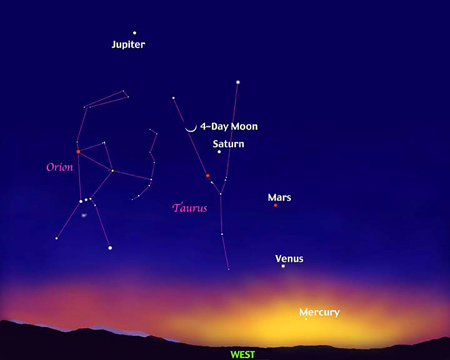All planets will be visible for once-in-a-lifetime sight

For the first time in most people’s lives, they will be able to see every planet in the solar system in one evening. The celestial show has already begun and will go on until early May. If you miss it, you’ll have to wait at least 70 years for a rerun.
“This is truly a once-in-a-lifetime experience,” notes Philip Sadler of the Harvard-Smithsonian Center for Astrophysics. “Seeing nine worlds in just one night is something few astronomers can say they’ve accomplished.”
The most familiar planets, Venus, Mars, Jupiter, and Saturn, winked into view in early April. Mercury has begun to slip out of the glare of the sun and will join the group next week. Looking west at sunset on a clear night, these five planets will be spaced out in an diagonal line from the horizon to almost overhead until mid-May.
To see Neptune and Uranus, you need a small telescope, 3 to 4 inches in lens size. Pluto, the planet that’s smallest and farthest away, requires an instrument of at least 10 inches. You also have to get up early, about 4 a.m. Additionally, a good telescope may let you see a few wandering asteroids and, perhaps, Comet Ikeya-Zhang in the eastern sky.
And there’s more
The next time five planets will be visible in such close formation will be in September 2040. The last time that the five brightest planets could be easily seen together in the evening sky was in June 1946. The three frozen outer worlds were also visible with a telescope, but Uranus was very difficult to see. The present line-up is more impressive and includes two other dramatic sights.
On May 5, Mars, Saturn, and Venus will form a small but striking triangle in the western sky at sunset. This awesome sight will be visible almost everywhere on Earth. In Israel, planets representing the mythical Roman gods of war, wisdom, and love, will hang directly above strife-torn Bethlehem.
More than 2,000 years ago, in 2 and 6 B.C., the same heavenly triangle was visible over that city. Some historians have speculated that the unusual sight attracted the Magi to Bethlehem to seek the Christ child. But Owen Gingerich, a Harvard astronomer and historian of science, disagrees. “A (sight) like this would have meant nothing to the Magi,” he insists. The paths that planets travel didn’t become part of astronomical knowledge until the 16th century, when Johannes Kepler discovered that they orbit the sun in elliptical not circular paths.
On May 10, these paths will bring Mars and Venus so close that they will appear to almost touch each other. On May 14, Venus and the crescent Moon come together in an appealing combination. Finally, on June 3, Venus and Jupiter, the brightest planets, will be only a finger-width apart.
All planetary paths lie in a single plane called the ecliptic. Ancient Greeks and Romans called it the Highway of the Gods. “Located directly behind this highway were the 12 special constellations the gods passed by as they moved across the sky,” notes Sadler. “These constellations constitute the signs of the zodiac.
Dates that mark these signs originate in movement of the sun from one star groups to the next every month. However, the position of Earth in space has changed since the signs were first named. For example, on March 23 when the zodiac sign is Aries, the sun is actually in the constellation Pisces.
The present alignment of inner planets appears near the constellation Orion. Whether you believe this rare sight has a special meaning, or it is just an astronomical coincidence, the event is too impressive to miss. To make it easier and more informative, the Harvard-Smithsonian Center for Astrophysics will host a series of “Star Parties,” beginning on Saturday, April 20, and running through May 16. Times and dates of the parties, live-cam images and a diagram of how the planets will appear are available at http://cfa-www.harvard.edu/grandtour.




